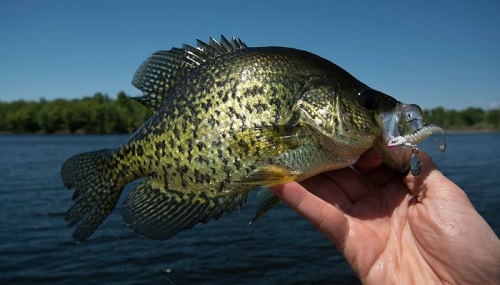 If your crappie tackle box doesn’t have bladed jigs, like the Road Runner Original Marabou Jig and the Bass Pro Shops Tube Stump Jumper Jigs, you’re missing a serious slab-catching bait. The design of this jig features a swivel and spinner blade connected to the underside of the head. This hardware gives them extra action crappie can’t resist. Here are 3 reasons why you need to fish a bladed jig for slabs in the fall:
If your crappie tackle box doesn’t have bladed jigs, like the Road Runner Original Marabou Jig and the Bass Pro Shops Tube Stump Jumper Jigs, you’re missing a serious slab-catching bait. The design of this jig features a swivel and spinner blade connected to the underside of the head. This hardware gives them extra action crappie can’t resist. Here are 3 reasons why you need to fish a bladed jig for slabs in the fall:

1. Slow Sink
A blade spinning in water creates turbulence. This creates a parachute-effect, which slows a jig’s sink rate. This gives an angler several advantages.
A slower fall keeps the jig in the strike zone longer. This is key for catching suspending, up-feeding crappie. The more “hang time” a bait has, the better it is at piquing fish interest and triggering bites on the drop.
A bladed jig works well for catching crappie relating to deep, lush grass in the fall. A common tactic is pitching a jig to the edges and cuts of the vegetation. Here, the jig’s slow fall prevents it from dropping like an anvil into the canopy. Hang-ups are part of the territory with this tactic, but they’re less severe with a bladed jig.
Another advantage of a bladed jig is that anglers can use a heavier weight than with a standard ball head jig. The blade counteracts the added weight and slows the fall. Out of the water, a heavier jig is handy for making long casts. It’s also easier to accurately cast in the wind.
The flash and thump of the jig’s blade rings the proverbial dinner bell for giant crappie. Slabs have big appetites in fall, and the more your bait looks like a meal, the more big fish you’re going to catch. Using a bladed jig replicates the sparkling moves of swimming baitfish.
Of course, the jig is only part of the equation. Rigging it with a 2- or 3-inch grub or minnow adds bulk to the presentation.
The flashy blade is also an asset at twilight, when crappie feed aggressively. The blade’s thump and flash attracts papermouths in the fading light. It’s a small detail, but it will catch you a few extra fish.
When crappie are walloping baits, there’s no guesswork whether you had a bite or not. Light biting slabs are another beast entirely.
Initially detecting a soft bite can be difficult. This is especially true when a crappie lightly sucks-in a regular jig while swimming up or forward. A bladed jig solves this problem.
With a sensitive rod and line, an angler will feel the vibrations of the bladed jig as it swims or falls. When a crappie bites, the jig’s vibrations stop. This is your cue to set the hook. If for no other reason, you should use a bladed jig because it helps you recognize when a sneaky slab mouths your bait.
When chasing crappie this fall, don’t launch the boat without some bladed jigs. Whether cast, trolled or jigged, these flashy heads are deadly on slabs.
Want to know more about fishing crappie in the fall? Check out these other great articles:
Tips for crappie lure colors
Spoons stellar for fall crappie
4 Tactics for summer-to-fall transition crappie


